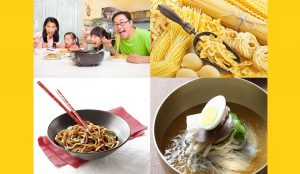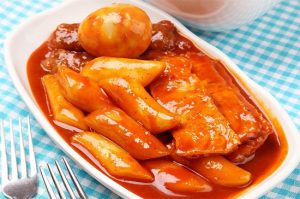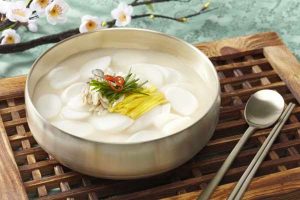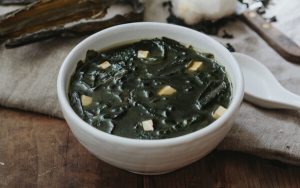Ramen and Ramyun in Korea
Ramen and is now popular everywhere. Ramen is a type of noodles with twisted strands usually cooked with chicken broth, beef broth, or pork broth. The noodle of ramen is typically made with wheat flour, salt, water and soda-infused water(kansui), which provides the light-yellow color of the noodle, chewy and slippery texture and its unique scent (Solt). The topping of the Ramen includes vegetables, seafood, meat, and eggs. Ramen varies in the type and taste. One of the most typical types of ramen is Instant noodle, which also has various flavors and styles. It is convenient and affordable but has sophisticated taste. Similar to the most of the noodles and foods, Ramen is closely related to the society and its culture. Notably, in Korea, Ramen is developed as one of the most crucial parts of the food cultures and society though is not traditional Korean food.
As of any other food, the origin of Ramen still on a debate, but most of the scholars thinks it started from China. Such claim of the professionals has highly credible assertion since the noodles and China is deeply associated. In China, a 4000-year-old fossil of a bowl is noodle was found. It is known as the earliest evidence of noodles ever found (Roach). Also, due to the vicinity of China and Japan, the cultural exchange had seldom happened in the past and present days, so it is conceivable that the recipe of Ramen or the root of the Ramen has started from China and transported to Japan (Solt). The scholars assume that Chinese merchants would have brought a bowl of soup what is now similar to today’s Ramen (Brickman). The first introduction of the Ramen can be assumed to be in the 1880s. In the busy port city of Yokohama, Japan, Chinese immigrants from Guangdong province worked as cooks at restaurants (Solt). The primary purpose of this restaurant was to serve students and foreign workers from their own country who is currently staying in Japan. However, in the 1910s, the Chinese chefs in the restaurant started to use the ingredients that are not formerly used such as “roasted pork, soy sauce, and pickled bamboo shoots” in the Chinese food (Solt). Japanese workers, student, and soldiers also started to consume the food, and the noodle soup served in the Chinese restaurants now became popular among Japanese.
Moreover, after the World War II, Ramen gained more popularity. Since Japan defeated from the war, food was scarce, and wheat flour, which is the main ingredient for making Ramen started to import from the United States. Those who returned from the Japanese occupied territory in China began Chinese restaurant and sold the noodles that now is called Ramen since they are familiar with the noodle-eating culture in China (“Correlation of Ramen…”). Though the root of the Ramen is China, later, Japanese had developed Ramen in different ways in a different region (Salt). With efforts of Japanese put on the development of Ramen, it became a national symbolic food of Japan and became one of the world favorites.
After the introduction of Ramen from China to Japan, Japanese Ramen became popular around the world, especially in Korea. On the streets of different cities around the globe, Japanese Ramen restaurant is easily found. Korea is one of them. There are two types of Ramen in Korea. One is called Ramen, which is a Japanese style Ramen, the other is called Ramyun, which refers to the Korean style instant noodles. We will first discuss the Ramen in Korea. Ramen is known as Japanese dish in Korea and influenced a significant part of Korea’s food industry. For instance, the restaurant called Aori Raman demonstrates the popularity of Ramen in Korea. Aori Raman is a Japanese style Ramen. They only sell one menu called Aori Ramen with customized toppings. The Aori Ramen is a type of Tonkotsu ramen, which is originated in Fukuoka, Japan. The soup is pork, and customers can add five different toppings: boiled pork, seaweed, boiled eggs, scallion, and fermented bamboo shoot (Kim Si Hwa). The Aori Raman restaurant first opened in 2016 in Seoul, Korea. In just two years, now, one Aori Raman in Seoul increased to 35 stores located not only in Seoul but also other parts of Korea. Their annual sales are approximately 25 billion (Lee Byeol Nim). This is just one example of Japanese Ramen’s cultural influence on Korea, but there are countless successful other Ramen restaurants in Korea. As shown in the sample, Ramen from Japan became a significant part of Korean culture as well.
Though Japanese style Ramen restaurant is a popular and thriving industry in Korea, Korean style Ramen, Ramyun is more familiar to most of the Koreans. It is more affordable and acquainted than Ramen with Koreans. Some Koreans may believe that Ramyun is distinctively different from Ramen and is Korean food but some may argue otherwise. Ramyun is different from what Korean define Ramen as. It refers to instant noodles or cup noodles. In a package of instant noodles, they typically have a chunk of pre-cooked dried noodle, powder, and solid ingredients. The instant noodles are cheap and easy to cook. For packaged instant noodles, you need put dried noodle, powder, and solid ingredients after water are boiled and put vegetables or eggs according to one’s taste. It is even easier for the cup noodles: you need to put hot water into the cup and wait for 5 minutes (“About Instant Noodles”). Such convenience and tastiness allowed Ramyun to be one of Korean’s favorite dish to eat.
The origin of Instant Noodles also started in Japan and brought to Korea. In 1958, the time when the people’s consumption patterns have significantly altered due to development of new media: television, the world’s first instant noodles were invented by Momofuku Ando. The first instant Ramen is called “Chicken Ramen,” which was sensational and gained sudden popularity. For Ramen to become a ready-to-eat meal, Momofuku Ando has used a method called epoch-making system, which is a technique of “dehydrating the steamed and seasoned noodles in oil heat” (“About Instant Noodles”). This simple method allowed the mass production of the instant noodles. This “Chicken Ramen” is cooked in just two minutes simply by boiling with the water, so it was called “a magic ramen” (“About Instant Noodles”). Later, due to people’s demand for better quality and taste, separately packaged flavoring powder was added. Furthermore, in 1962, healthier version of noodles was invented. The noodles no longer needed to be fried but were dried with heat (“History of Ramen…”). Then many types and flavors of instant noodles were launched, enhancing the taste of the products.
Moreover, the cup noodles were invented in Japan as well. The cup noodles are instant noodles in cups. The most significant advantage of the cup noodle is the convenience. In contrast to the packaged instant noodles, you do not need to cook cup noodles. With the product and hot water, ramen is prepared anytime and everywhere. In 1971, CUP NOODLES® was introduced to the world. It was another revolutionary discovery of Ramen and one of the sensational inventions in the food industry. Inside the Styrofoam container, flavored noodles, dried shrimp, dehydrated pork, dehydrated vegetables, and dried eggs were included (“About Instant Noodles”). Such developments of Ramen had stimulated Koreans to create their version of Ramyun.
The first Ramen in Korea was instant noodle developed by Samyang Ramyun. In 1963, Jung Yun Jeon, a founder of Samyang Food Company, introduced the technology of making Ramen from Japan to Korea. The reason why he imported the skill from Japan is similar to that of Japanese noodle got popularity. Due to the poverty after Korean War, Jeon decided to sell Ramyun as a solution to the problem (Kim Timothy). It was sold for 10 won, which can be converted to approximately 1 cent in U.S. dollars today. Though the primary purpose of the Ramyun was to solve the poverty, Ramyun soon became one of Korean’s favorite dish. Interestingly, Korea leads per capita consumption of instant noodles. In 2017, Korea had 73.4 million servings per capita, which is exceptionally high compared to Vietnam (53.5 servings million per capita), the second highest and Nepal (51.1 million servings per capita), the third highest (“About Instant Noodles”). This data shows how Ramyun became crucial to Korean culture, people, and daily life.
Since the 1960s, as Korea interact more internationally, Koreans rapidly expanded their presence all over the world. While Koreans are abroad they homesick and look for authentic but convenient Korean food (Lee, Joel). Ramyun was the perfect fit for the demand because it has Korea’s traditional spicy flavor and easy to cook. The rapid increase of Ramyun demand mainly from Koreans and other Asians made Ramyun market grew internationally. As a result, Ramyun manufactures exported their product to other countries, and it started to roll out of Korean and Asian groceries to some of the big local players. In recent years, as Korean culture (food especially) become more mainstream than before, more and more people started to consume Ramyun fascinated by its convenience, low price and stimulating taste. According to Food Focus a Korean newspaper reporting mainly on food and beverage issues in Korea, international sales of Korean Ramyun in 2016 was 290,366 thousand U.S. dollars, and this is 60.8% increase from 5 years before (Lee Jae Hyeon). To be more specific, China, The United States, Japan, and Taiwan are countries are the top consumers of Korean Ramyun and sales is keep increasing except for Japan. In the case of Japan, the consumption is not necessarily decreasing, but because of Abenomics policy, an Abe administration’s economic strategy to reduce the value of the yen to take advantage in international trading. It was only the sales amount that was decreased (“Abenomics”), which implies that Korean Ramyun demand and market all over the world had been getting more prominent, and the precedent shows that the trend will continue in the future as well.
As the Ramyun grew bigger on Koreans, new Ramyun reflecting people’s altering palate is launched. The Ramyun released in the past such as Shin Ramyun, Samyang Ramyun, and Neoguri Ramyun usually emphasizes on its spicy taste, so the red soup with red papers was a typical look of the instant noodle (“Timeline of History…”). However, Ramyun companies started to react to altering consumers’ tastes. The different type of instant noodles such as Black noodle Ramyun with black sauce and Kkokkomyeon with white broth was released. Moreover, the companies tried to break the stereotypical appearance of Korean instant noodles. Ramyun only with the sauce dried vegetables, seafood, or meats and without the soup was launched in Korea and gained popularity. For example, Hot Chicken Flavor Ramen started in April 2012. When it was first released, this noodle did not gain much attention. The Ramyun liquid type sauce and the absence of the soup even made it spicier than typical Ramyun. Soon, the consumers were attracted to its spicy but addictive taste. In 2015, the annual sales of Hot Chicken Flavor Ramen were 66.2 billion won, and in 2016, the sales increase approximately 50% to 138 billion won, which is a drastic increase (Lee Yu Jeong). As society change, Ramyun also reflects the trend and taste of consumers, which shows the correlation between the Korean society and Ramyun.
Even though Ramyun has a lot of benefits such as its affordable price and convenience in cooking, there always has been a critical problem which it affects health negatively. Ramyun’s noodle is mostly fried and made out of flour. Too much of food that is fried and made out of flour causes obesity which leads to heart disease, diabetes depression and more. Ramyun’s soup powder also causes problems. The primary cause is its sodium content. According to USDA, Shin Ramyun contains 2000mg of sodium a bowl (“Food Composition Databases…”). This is over 80% of daily value in sodium. Considering most people eat three meals per day, Ramyun eaters will easily consume more sodium than what USDA suggested. Too much sodium consumption results in various cancers, high blood pressure, osteoporosis and other crucial diseases.
Knowing that many consumers nowadays care about what they eat and try to eat healthily, Ramyun manufacturers are making their product healthier than before. Pulmuone’s “Real Noodle Texture” is a new product which uses a dried noodle to avoid frying (“Pulmuone’s” New Ramen…”), and Paldo launched “Paldo Bibim Myun” which its noodle contains kudzu root to reduce flour content. With these efforts, they could decrease the calories so that consumers can avoid obesity. There are also several products which reduced sodium content. Nongshim’s “Nuguri” rolled out mild taste which contains 1480mg of sodium. This is 280mg less than the regular version, and it was a massive hit in the market (Lee Seung Hyun). Ramyun companies’ effort to make the healthier product and to reflect the current trend of the society stimulates the expansion of consumers who enjoy Ramyun.
Moreover, since Korean society and the instant noodles are highly intertwined, Ramyun is often used as a symbol even in literary works. When an object is used as a symbol in a poem, it must be representative enough for the audience to understand. Most of the times, Ramyun is used as a symbol of loneliness because a person can effortlessly cook the instant noodle without any experience with cooking. Therefore, in contrast to other food made by the one’s mom or wife, the instant noodle is often compared with agony or hardship of life. For example, in the poem, While Boiling the Ramyun, by Gu Chan Jeong, a leading poet in Korea, the speaker describes his loneliness and the situation of absence of his wife using Ramyun (Jeong).
Ramen became a detachable culture to Koreans and the culture. Though both Ramen and Ramyun in Korea originated from a foreign country, Koreans embraces and values the noodles. As proved through Ramen, noodles, and food has unique and strong ability influence individual’s culture on a small scale and even the world in a larger size. Though some people are unconscious of the impact of food on the society, the food and culture is deeply intertwined and is inseparable.
Works Cited
“ABENOMICS.” JapanGov, www.japan.go.jp/abenomics/index.html.
“About Instant Noodles.” History | World Instant Noodles Association., World Instant Noodles Association, instantnoodles.org/en/noodles/index.html.
“Correlation of Ramen and the History of Korea, China, and Japan[라면’에 얽힌 한·중·일
3국의 역사, 기원이 ‘중국’이라고?].” Chosun,Com Food, 10 May 2012,
food.chosun.com/site/data/html_dir/2012/05/10/2012051000851.html.
“Food Composition Databases Show Foods — SHIN BOWL NOODLE SOUP, UPC: 031146262441.” Edited by USDA.gov, Food Composition Databases Show Foods — Oil, Soybean, Salad or Cooking, ndb.nal.usda.gov/ndb/foods/show/501181?manu=%2CSHIN%2BBOWL%2BNOODLE%2BSOUP%2C%2BUPC%3A%2B031146262441.
“History of Ramen [라면의 역사].” Nongshim, www.nongshim.co.kr/ramyun/history1.
Jeong, Gu Chan. The House Where Letters Live [글씨가 사는 집]. Ppuli [뿌리], 2015.
Kim Si Hwa[김시화]. “Aori Ramen[아오리라멘].” Time Out Seoul,1 May 2017, www.timeoutkorea.kr/seoul/ko/restaurants/%EC%95%84%EC%98%A4%EB%A6%AC%EB%9D%BC%EB%A9%98.
Kim Timothy [ 김디모데]. “50years Of History of Ramen, Why Did Samyang Failed[50년
라면의 ‘역사’ 삼양은 왜 추락했나].” Business Post, 4 Apr. 2014, admin.businesspost.co.kr/BP?command=article_view&num=1193.
Lee Byeol Nim[이별님]. “‘Annual Sales of 25million’…Seungli’s 5 Successful Business [‘연 매출 250억’…’승츠비’ 빅뱅 승리의 사업 성공 사례 5가지].” Insight [인사이트], 16 Mar. 2018, www.insight.co.kr/news/144949.
Lee Jae Hyeon [이재현]. “The Largest Ramen Export Ever…32% Increase[라면, 수출
역대 최고치…작년 32% 급증].” Food Focus Newspaper [식품음료신문], 19 Dec. 2017, www.thinkfood.co.kr/news/articleView.html?idxno=78346.
Lee Seung – Hyun[이승현]. “The Reason of Neoguli and Yuggaejang’s Long-Run [너구리·육개장사발면 30년간 장수 비결].” E Daily News, 14 Feb. 2012, www.edaily.co.kr/news/news_detail.asp?newsId=02276326599430520.
Lee, Joel. “Korean Miners, Nurses Recall Their Arduous Days in Germany.” The Korea
Herald, 9 Oct. 2017, www.koreaherald.com/view.php?ud=20171009000324.
Lee Yu Jeong[이유정]. “Hot Chicken Noodles’s Annual Sales over 250 Million Became
Samyang’s Representative Ramen [불닭볶음면 2500억 ‘화끈한 매출’… 삼양식품 간판라면 꿰찼다].” Hankyung.com, 4 Dec. 2017, news.hankyung.com/article/2017120485741.
“Pulmuone’s New Ramen with Raw Noodle Texture[풀무원 라면 브랜드 ‘생면식감’으로 새로 론칭… ‘비유탕 라면’ 확대].” Pulmuone News Room[풀무원 뉴스룸], 8 June 2017, news.pulmuone.kr/pulmuone/newsroom/viewNewsroom.do?id=842.
Roach , John. “ 4,000-Year-Old Noodles Found in China.” National Geographic, National Geographic Society, 12 Oct. 2005, news.nationalgeographic.com/news/2005/10/1012_051012_chinese_noodles.html.
Solt, George. The Untold History of Ramen: How Political Crisis in Japan Spawned a Global Food Craze. University of California Press, 2014.
“Timeline of History of Korea’s Ramen[우리나라 라면의 역사 비교연표].” Webmona, The
Matrix Timeline, ko.webmona.org/view.php?s_page=4&s_topic_ids=100.


 Tteokbokki is the food that misses eating the most when I am abroad. From a young age, I studied abroad in the United States without my parents. When I visit Korea during breaks, the first thing I would ask for my mom is to cook Tteokbokki.
Tteokbokki is the food that misses eating the most when I am abroad. From a young age, I studied abroad in the United States without my parents. When I visit Korea during breaks, the first thing I would ask for my mom is to cook Tteokbokki. Tteokguk, to some Koreans
Tteokguk, to some Koreans Miyeokguk is my favorite Korean soup and is special to me because my mom used to cook for me on my birthdays. However, for six years, I have not eaten Miyeokguk on my birthday because my birthday is in during the school year. I hope I can go back to Korea soon on my birthday and enjoy my birthday M
Miyeokguk is my favorite Korean soup and is special to me because my mom used to cook for me on my birthdays. However, for six years, I have not eaten Miyeokguk on my birthday because my birthday is in during the school year. I hope I can go back to Korea soon on my birthday and enjoy my birthday M